Are you curious about the number of calories in a large biscuit? As a health-conscious individual, it’s essential to be aware of the calorie content in your favorite treats. In this article, I will delve into the topic of calorie counts in large biscuits and explore the different factors that can influence the calorie content.
- The calorie count of a standard-sized biscuit is typically around 200-250 calories.
- Larger biscuits can contain 300-400 calories due to their size and ingredients used.
- Ingredients like butter, sugar, and fillings such as cheese or bacon can contribute to the overall calorie count.
- Cream cracker biscuits are high in carbohydrates, saturated fats, and sugar, making them unsuitable for weight loss.
- Opt for healthier snack alternatives like cereal bars or veggie-based crackers for weight loss.
- Practice mindful eating and portion control for better calorie management.
Knowing the calorie content in a large biscuit empowers you to make informed choices and maintain a balanced diet. Let’s explore the fascinating world of biscuit calories together!
How Many Calories Are in a Standard-Sized Biscuit?
Before we dive into larger biscuits, let’s take a look at the calorie count in a standard-sized one. It’s important to have a baseline to compare against when discussing larger biscuits. On average, a standard-sized biscuit contains around 200-250 calories. However, this can vary depending on the brand and specific recipe.
While 200-250 calories may not seem like a lot, it’s important to consider portion sizes. One biscuit may not be overly high in calories, but if you consume multiple biscuits in one sitting, the calorie count can quickly add up. It’s essential to be mindful of your portion sizes and overall caloric intake, especially if you are watching your weight.

By being aware of the calorie count in a standard-sized biscuit, you can make informed choices about how many biscuits to consume and adjust your daily calorie intake accordingly. Remember, it’s all about balance and moderation when it comes to enjoying your favorite treats while maintaining a healthy lifestyle.
Calorie Counts in Popular Biscuits
| Biscuit | Calories |
|---|---|
| Butter biscuit | 230 |
| Chocolate chip biscuit | 220 |
| Oatmeal biscuit | 180 |
| Shortbread biscuit | 150 |
Keep in mind that the calorie counts listed here are approximate values and can vary slightly depending on the specific brand and recipe. Always check the nutrition label on the packaging for the most accurate information.
Next, let’s explore the factors that can influence the calorie content of larger biscuits and understand the importance of knowing this information.
Factors That Influence Calories in Larger Biscuits
The calorie count in a large biscuit can be influenced by various factors. Let’s explore these factors in detail.
Firstly, the size of the biscuit plays a significant role in determining its calorie content. As a general rule, larger biscuits tend to have more calories compared to standard-sized ones. This is because a larger biscuit typically contains more dough, which contributes to the overall calorie count. However, it’s important to note that the size of a biscuit alone is not the sole determinant of its calorie content. Other factors, such as the ingredients used, also come into play.
The ingredients used in a biscuit can greatly impact its calorie count. Ingredients like butter, sugar, and fillings such as cheese or bacon can significantly increase the calorie content. These ingredients not only add flavor but also add calories. For example, a biscuit with added cheese or bacon can easily have double the calorie count of a plain biscuit. It’s essential to be mindful of the ingredients used and make informed choices to manage calorie intake.
In addition to size and ingredients, the cooking method can also influence the calorie count of a biscuit. Biscuits that are fried or deep-fried tend to have higher calorie content compared to those that are baked. Frying increases the fat content and overall calorie count of the biscuit. Opting for baked biscuits or choosing healthier cooking methods can help reduce calorie intake while still enjoying a tasty treat.
To summarize, the calorie count in a large biscuit can vary depending on the size, ingredients, and cooking method. Understanding these factors is crucial for individuals who are mindful of their calorie intake. By making informed choices and being aware of portion sizes, it’s possible to enjoy biscuits as part of a balanced diet.
Factors That Influence Calories in Larger Biscuits:
| Factors | Description |
|---|---|
| Size | Larger biscuits typically have more calories compared to standard-sized ones due to their increased dough content. |
| Ingredients | Butter, sugar, and fillings like cheese or bacon can significantly contribute to the calorie count of a biscuit. |
| Cooking Method | Fried or deep-fried biscuits tend to have higher calorie content compared to baked biscuits. |
“Understanding the factors that influence the calorie count of larger biscuits is essential in making informed choices and maintaining a balanced diet.”
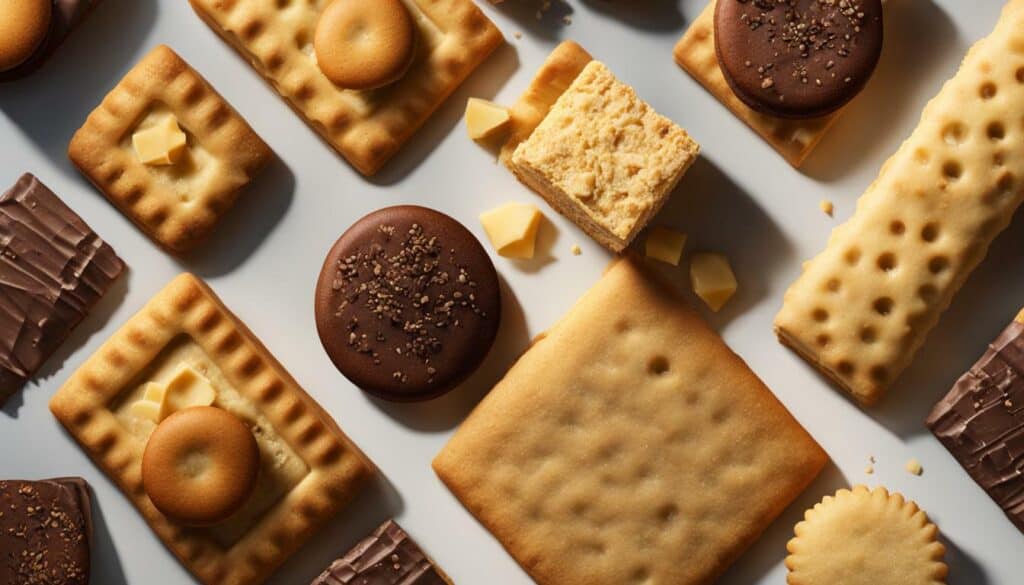
The image above illustrates the calorie content variation in different sizes and types of biscuits.
“Size, ingredients, and cooking method all play a role in determining the calorie count of a biscuit. By being mindful of these factors and making conscious choices, individuals can enjoy their favorite biscuits while managing their calorie intake.”
Size Matters: The Impact of Biscuit Size on Calories
It’s no surprise that the size of a biscuit plays a role in its calorie count. Let’s explore this further.
A larger biscuit naturally contains more calories than a standard-sized one. On average, a standard-sized biscuit is typically around 200-250 calories. However, when we indulge in a larger biscuit, we can expect the calorie count to increase to around 300-400 calories. This increase is due to the larger proportion of ingredients used in the dough, resulting in a higher calorie content.
| Biscuit Size | Calorie Count |
|---|---|
| Standard-Sized | 200-250 |
| Larger | 300-400 |
Aside from the size, the ingredients used in the biscuit also contribute to its calorie count. Ingredients such as butter, sugar, and fillings like cheese or bacon can significantly increase the calorie content. These ingredients add flavor and richness to the biscuit but also come with additional calories.
When considering the calorie count of a biscuit, it’s important to be mindful of portion sizes and make informed choices. Opting for nutrient-dense snacks like cereal bars or veggie-based crackers can be a better option for those watching their weight. These alternatives offer a lower calorie content while still satisfying cravings.
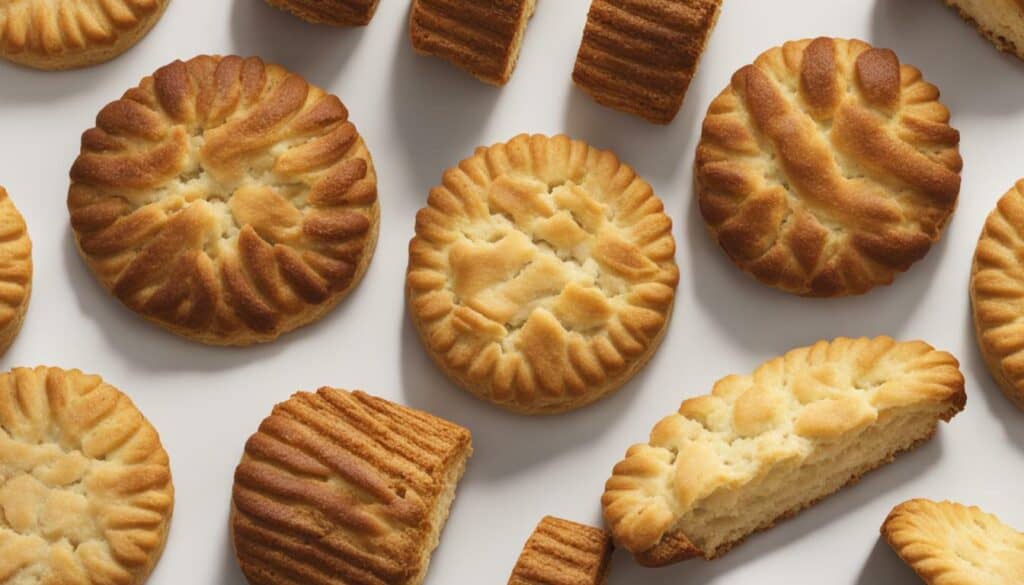
By understanding the impact of biscuit size on calories and making conscious decisions about ingredients and portion sizes, we can enjoy our favorite treats without compromising our health goals. Remember, knowledge is power, and being aware of the calorie content in a large biscuit is a step towards a balanced diet.
Ingredients That Contribute to Higher Calories
The ingredients used in biscuits can greatly influence how many calories they contain. Let’s take a closer look at these ingredients:
- Butter: Butter is a common ingredient in biscuits and adds a rich, creamy flavor. However, it also adds a significant amount of calories. Just one tablespoon of butter can contribute around 100 calories to a biscuit.
- Sugar: Biscuits often contain sugar, which not only enhances sweetness but also adds to the calorie count. Sugar is a source of empty calories without providing much nutritional value.
- Fillings: Fillings like cheese or bacon can turn a simple biscuit into a more indulgent treat. While these fillings add flavor and texture, they also contribute additional calories. Cheese, for example, is high in fat and calories.
It’s important to be aware of these ingredients and their impact on the overall calorie content of biscuits. While these ingredients can make biscuits more delicious, they can also make them high in calories.
“The ingredients used in biscuits can greatly influence how many calories they contain.”
By understanding the calorie content of different ingredients, we can make informed choices about the biscuits we consume. It’s always a good idea to check the nutrition facts of biscuits before indulging, especially if you are watching your calorie intake.
| Ingredient | Calories per Serving |
|---|---|
| Butter (1 tablespoon) | around 100 calories |
| Sugar (1 teaspoon) | around 20 calories |
| Cheddar Cheese (1 ounce) | around 115 calories |
| Bacon (1 slice, cooked) | around 43 calories |
Being mindful of the ingredients and portion sizes can help us enjoy biscuits in moderation while still maintaining a balanced diet. Remember, it’s all about making informed choices and finding a healthy balance.
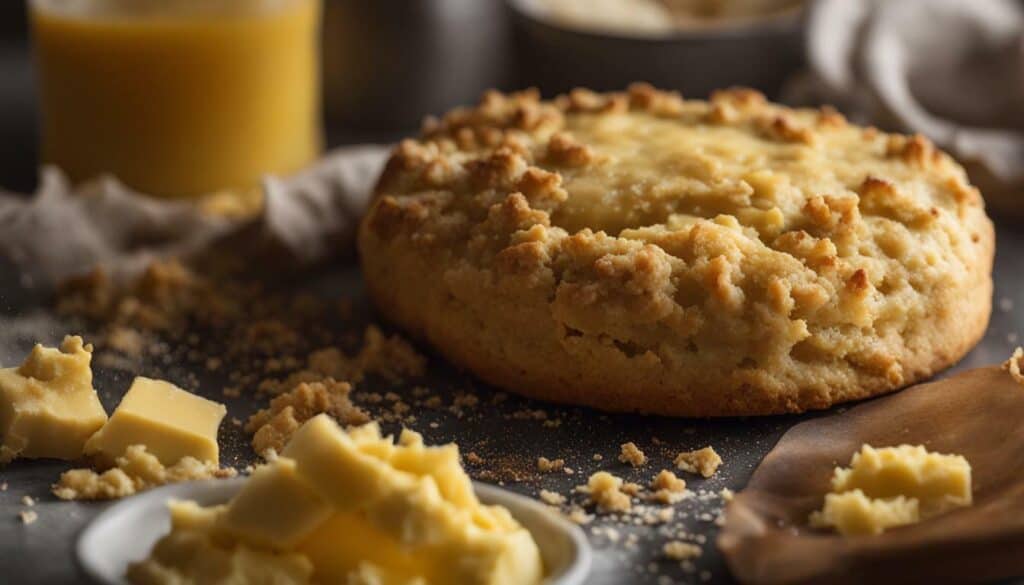
The Role of Butter, Sugar, and Fillings in Calorie Content
Let’s discuss the role of butter, sugar, and fillings in determining the calorie content of a biscuit. These ingredients can significantly contribute to the overall calorie count, making it important to be aware of their impact.
Butter is a common ingredient in biscuits that adds richness and flavor. However, it is also high in calories and fat. Just one tablespoon of butter can add around 100 calories to a biscuit. If a large biscuit contains multiple tablespoons of butter, the calorie count can quickly increase.
Sugar is another ingredient that can significantly contribute to the calorie content of a biscuit. Biscuits with added sugar or sweet fillings like jam or cream can have a higher calorie count. It’s important to be mindful of the amount of sugar in a biscuit, as excessive sugar intake can lead to various health issues.
Fillings like cheese or bacon can also add to the calorie count of a biscuit. These ingredients are often high in fat and calories, so it’s important to consider their impact when choosing a biscuit. While they may add delicious flavors, they can also contribute to weight gain if consumed in excess.
The Importance of Choosing Wisely
When it comes to counting calories in a large biscuit, it’s crucial to consider the role of butter, sugar, and fillings. These ingredients can significantly impact the overall calorie content, making it important to choose wisely. Opting for biscuits with healthier ingredients or lower-calorie alternatives can help in managing calorie intake while still enjoying a tasty treat.
| Ingredient | Calories per Serving |
|---|---|
| Butter (1 tbsp) | ~100 |
| Sugar (1 tsp) | ~16 |
| Cheese (1 slice) | ~100 |
| Bacon (1 slice) | ~42 |
By being mindful of the calorie content and the ingredients used in biscuits, you can make informed choices that align with your dietary goals. Remember to practice portion control and consider healthier alternatives when managing your calorie intake. Enjoy your biscuits in moderation, and don’t forget to savor every bite!
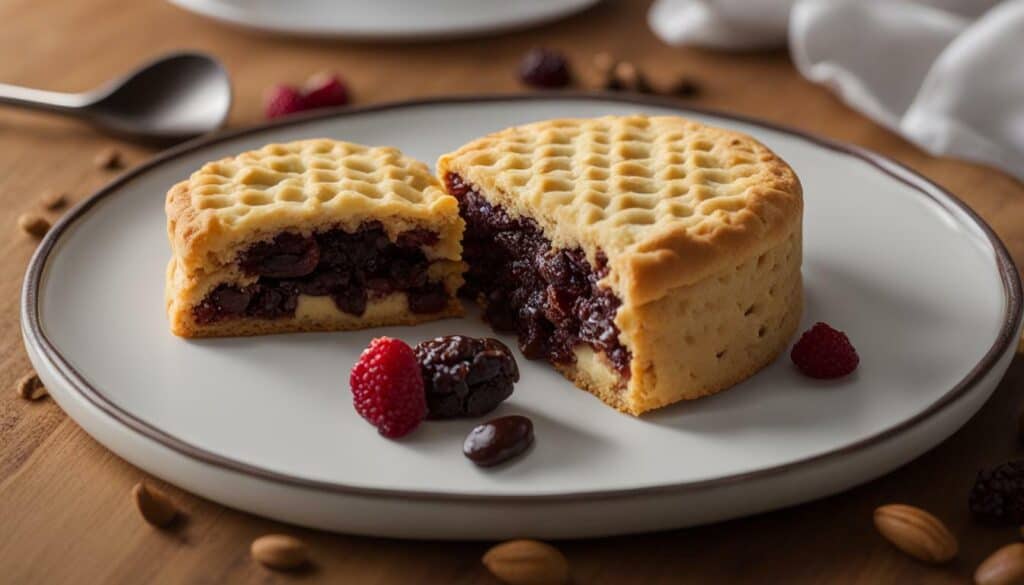
If you’re trying to shed some pounds, cream cracker biscuits may not be the best choice. Let’s explore why.
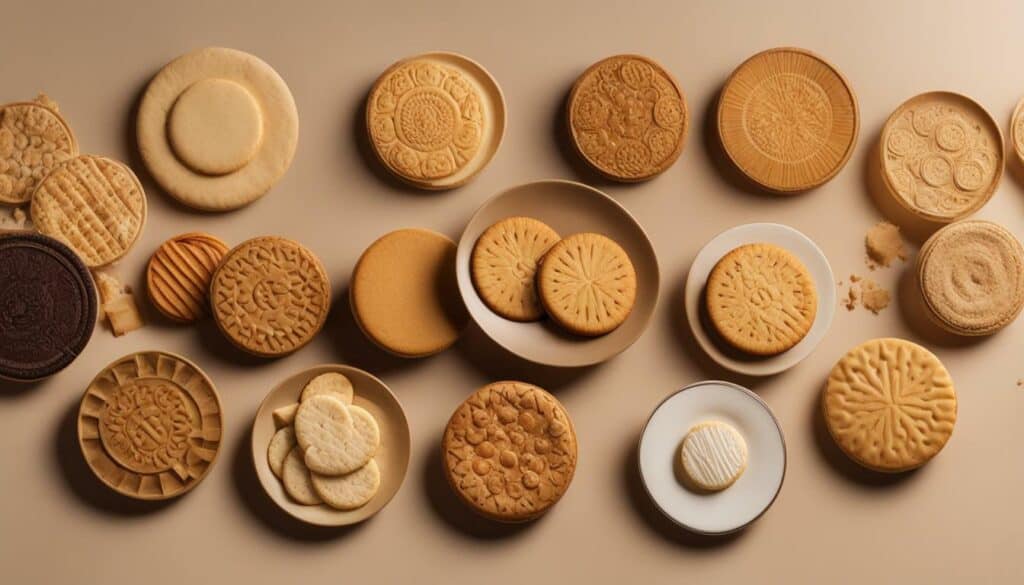
Cream crackers are a popular choice when it comes to biscuits, but they can hinder your weight loss goals due to their high carbohydrate, saturated fat, and sugar content. These factors make them a calorie-dense snack that can contribute to weight gain rather than weight loss.
Let’s take a closer look at the nutrition information of cream crackers. A typical serving size of cream crackers (about 4 to 6 crackers) can contain around 150-200 calories. These calories mainly come from carbohydrates, which are quickly absorbed by the body and can lead to a spike in blood sugar levels. In addition, cream crackers are often made with hydrogenated oils, which are high in unhealthy trans fats.
Instead of cream crackers, consider healthier options for your weight loss journey. Cereal bars with whole grains and low sugar content can provide a satisfying crunch without the excessive calories. Veggie-based crackers, made with ingredients like chickpeas or lentils, are another great alternative. These snacks offer a good dose of fiber and protein, which can help keep you feeling full for longer.
Remember, making mindful choices and being aware of the nutrition information in biscuits and other snacks is key to achieving your weight loss goals. By opting for nutrient-dense options and practicing portion control, you can still enjoy delicious treats while staying on track. Choose snacks that nourish your body and support your well-being.
Better Options for Weight Loss
Fortunately, there are plenty of better options out there for those on a weight loss journey. Let’s discover some of these healthier snack alternatives.
When it comes to snacking, it’s important to choose nutrient-dense options that can help you stay satisfied without packing on excessive calories. One great choice is a homemade trail mix. By combining a mix of nuts, seeds, and dried fruits, you can create a snack that is rich in healthy fats, protein, and fiber. Plus, it’s customizable to your taste preferences!
Another delicious and satisfying option is veggie-based crackers. These crackers are typically made from vegetables like kale, spinach, or sweet potatoes, providing a nutritious alternative to traditional biscuits. They are often packed with vitamins and minerals, making them a great choice for those looking to boost their nutrient intake.
For those with a sweet tooth, cereal bars can be a great snack option. Look for bars that are made with whole grains, nuts, and seeds, and are low in added sugars. These bars provide a convenient and tasty way to satisfy cravings while still staying on track with your weight loss goals.
| Snack | Calories | Key Nutrients |
|---|---|---|
| Homemade Trail Mix | Varies depending on ingredients | Healthy fats, protein, fiber |
| Veggie-Based Crackers | Around 100 calories per serving | Vitamins, minerals |
| Cereal Bars | Approximately 150-200 calories per bar | Whole grains, nuts, seeds |
Remember, when choosing snacks for weight loss, portion control is key. It’s important to be mindful of serving sizes and avoid mindless eating. By incorporating these healthier snack alternatives into your diet, you can still enjoy delicious treats while staying on track with your weight loss journey.

To maintain a healthy diet, it’s important to practice mindful eating and portion control. Let’s explore why these practices are essential.
Mindful eating involves being fully present and aware of your eating experience. It means paying attention to the flavors, textures, and sensations of each bite. By practicing mindful eating, you can better listen to your body’s hunger and fullness cues, which can help prevent overeating.
One way to incorporate mindful eating is by slowing down during meals. Take the time to savor each bite, chewing slowly and fully experiencing the taste and texture. This allows your brain to register feelings of satisfaction, making you more aware of when you’ve had enough.
Portion control is another important aspect of maintaining a balanced diet. It involves understanding appropriate serving sizes and being mindful of how much you are consuming. By controlling your portions, you can prevent consuming excess calories and maintain a healthy weight.
A helpful tool for portion control is using smaller plates and bowls. This visual trick can make your portions appear larger, tricking your brain into feeling more satisfied with less food. Additionally, measuring utensils and food scales can provide more accurate portion sizes, especially when it comes to calorie-dense foods.
By practicing mindful eating and portion control, you can enjoy your favorite biscuits while still maintaining a balanced diet. Remember to be aware of your body’s cues and make conscious choices about portion sizes. Your body will thank you for it!
| Food | Serving Size | Calories |
|---|---|---|
| Standard-sized biscuit | 1 biscuit | 200-250 |
| Large biscuit | 1 biscuit | 300-400 |
| Cream cracker biscuits | 4 crackers | 145 |
| Cereal bar | 1 bar | 130-200 |
| Veggie-based crackers | 1 serving | 100-150 |
Conclusion
Counting the calories in a large biscuit can make a significant difference in managing our overall calorie intake. Understanding the factors that contribute to the calorie count, such as size and ingredients, empowers us to make informed choices about our favorite treats while still maintaining a balanced diet.
A standard-sized biscuit typically contains around 200-250 calories, but larger biscuits can pack in 300-400 calories or more. Ingredients like butter, sugar, and fillings, such as cheese or bacon, can also significantly add to the calorie count.
When aiming for weight loss, it’s important to avoid cream cracker biscuits due to their high content of carbohydrates, saturated fats, and sugar. Instead, opt for healthier alternatives like cereal bars or veggie-based crackers. These options provide nutrient-dense alternatives that can help satisfy cravings without consuming excessive calories.
Furthermore, practicing mindful eating and portion control is essential for managing calorie intake. Being aware of portion sizes and practicing moderation can help us enjoy our favorite treats without derailing our weight loss goals. By making conscious choices and selecting nutrient-dense snacks, we can make progress towards a healthier lifestyle.
FAQ
Q: How many calories are in a standard-sized biscuit?
A: A standard-sized biscuit typically contains around 200-250 calories.
Q: Can the calorie count of a large biscuit vary?
A: Yes, the calorie count of a large biscuit can vary depending on factors such as size and ingredients used.
Q: How many calories can a larger biscuit contain?
A: A larger biscuit can contain around 300-400 calories.
Q: What ingredients can contribute to higher calories in biscuits?
A: Ingredients like butter, sugar, and fillings such as cheese or bacon can contribute to higher calorie counts in biscuits.
Q: Are cream cracker biscuits recommended for weight loss?
A: No, cream cracker biscuits are not recommended for weight loss as they are high in carbohydrates, saturated fats, and sugar.
Q: What are some better options for weight loss?
A: Other snacks like cereal bars or veggie-based crackers can be better options for weight loss, as they are lower in calories and higher in nutrients.
Q: How important is mindful eating and portion control?
A: Mindful eating and portion control are crucial for managing calorie intake and maintaining a balanced diet.

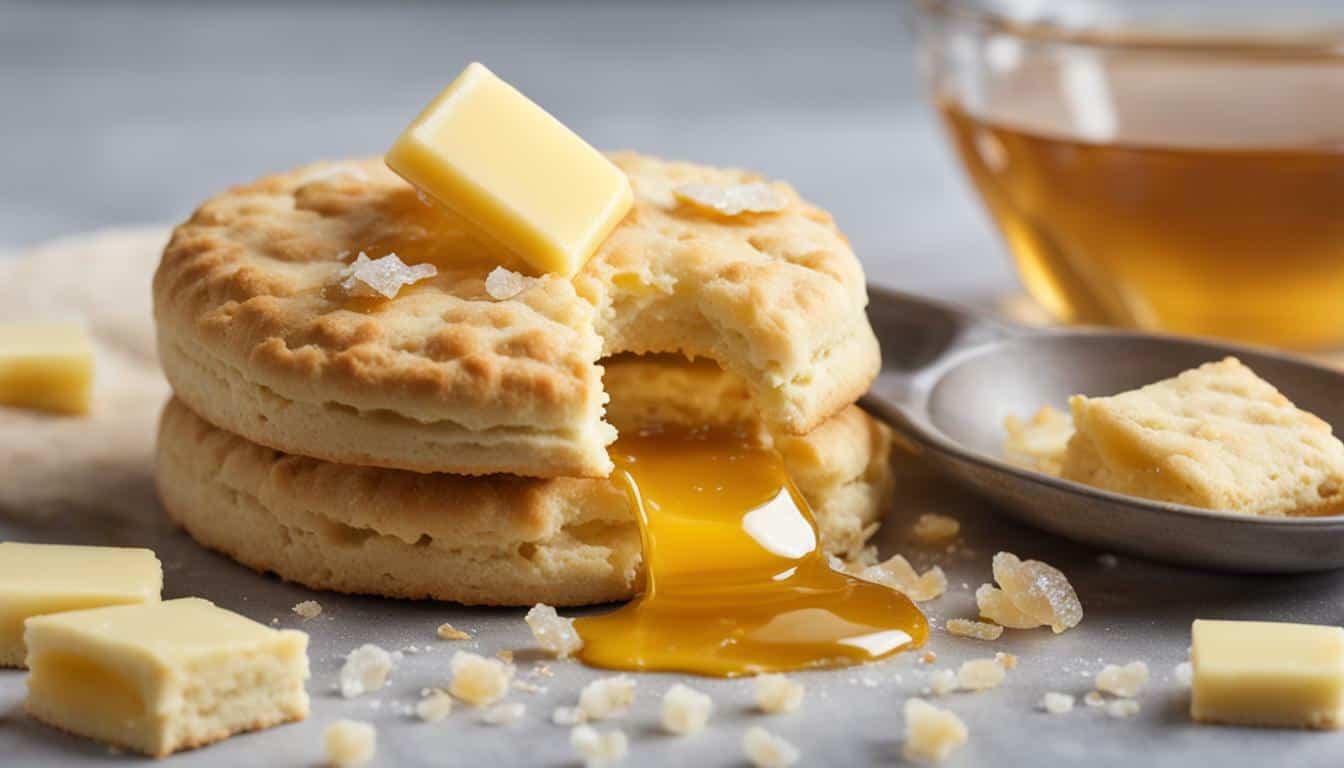



Leave a Reply